Appam (also known as “palappam”) are tasty, lacy and fluffy pancakes or hoppers from the Kerala cuisine that are made from ground, fermented rice and coconut batter. Thin and crispy around the edges with soft fluffy center appam taste delicious when paired with vegetable stew for a hearty vegetarian breakfast. They also just so happen to be gluten-free and vegan.
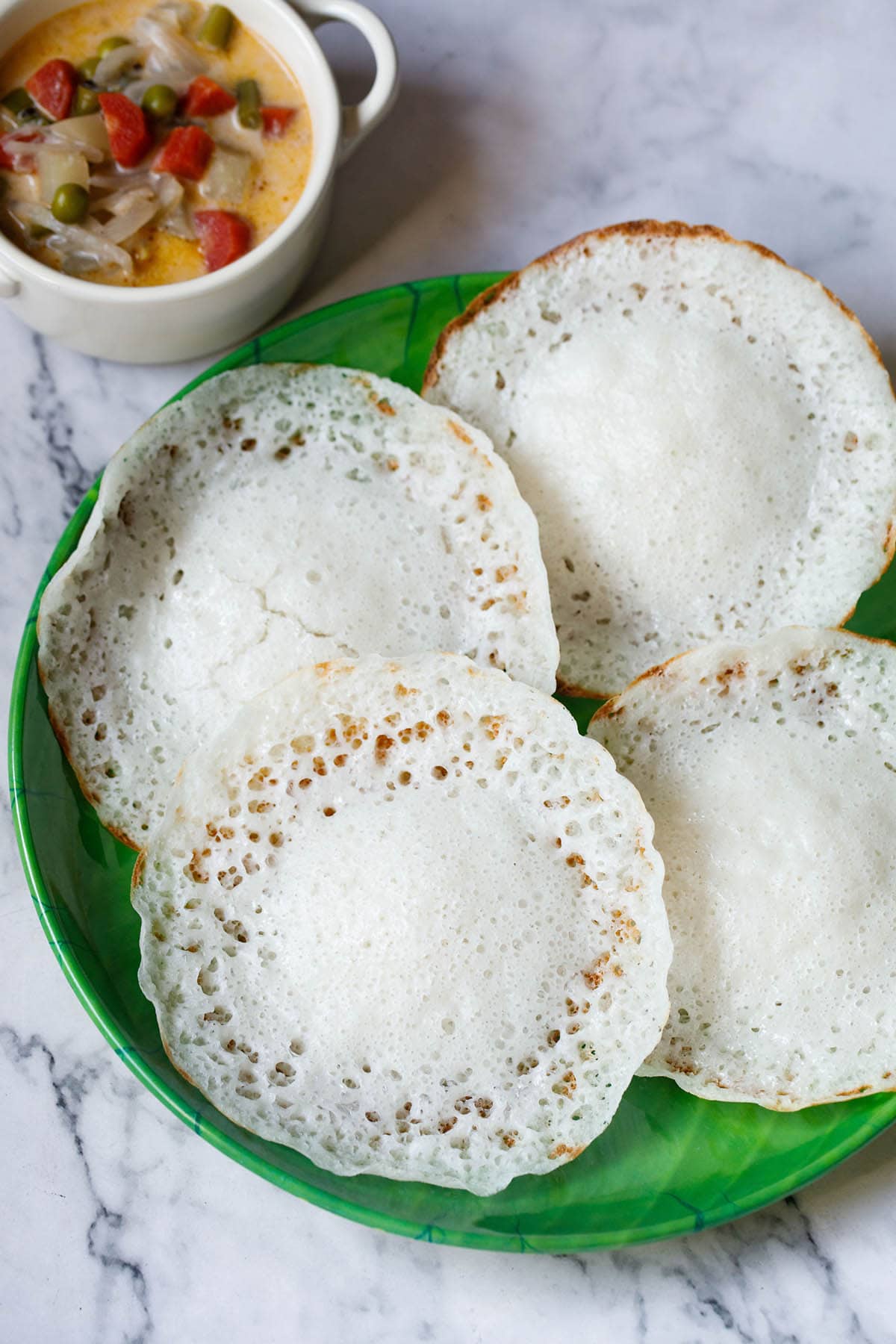
About Appam Recipe
Appam is one of our favorite breakfast dishes, so I make them on the weekends at least once a month. The preparation is similar to making Dosa Batter, and needs some prep work beforehand.
Traditionally, appam are fermented with a local alcoholic drink known as toddy – which is a drink made from palm flower or coconut flower.
Toddy, which is made from palm flower or coconut flower, is also known as “kallu” in Tamil and Malayalam or “tadi” in Hindi.
Since toddy is not readily available everywhere, I make these appam with yeast. Both dry active yeast and instant yeast works as a good fermenting agent and is easy to find the world over. This, however, does not mean that you cannot make appams without yeast.
Please note that there will be some flavor differences between appam made with toddy versus those made with yeast.
Appam can be made both dry active yeast or instant yeast (rapid rise yeast). I use either depending on what is there on hand. With instant yeast the fermentation time is very less as compared to fermentation with dry active yeast.
Table of Contents
In this post I share both the methods of making palappam with these two types of yeast. The instant yeast is directly added to the batter. If using dry active yeast activate it in lukewarm water and then add it to the batter later.
To make these appam, I opted to add fresh grated coconut while grinding the batter instead of coconut milk. You can use coconut milk instead of grated coconut – about 1 cup of thick coconut milk will suffice.
Appams are served with vegetable stew, kadala curry (chickpea curry), potato stew, vegetable korma, coconut chutney or coconut milk sweetened with jaggery.
To make my favorite sweet coconut milk for pairing with palappam, the coconut milk is sweetened with jaggery and flavored with cardamom powder.
Pour the desired amount of coconut milk you wish to sweeten into a cup. Add powdered jaggery to taste, along with a bit of cardamom powder. Stir very well until the jaggery is dissolved. Enjoy!
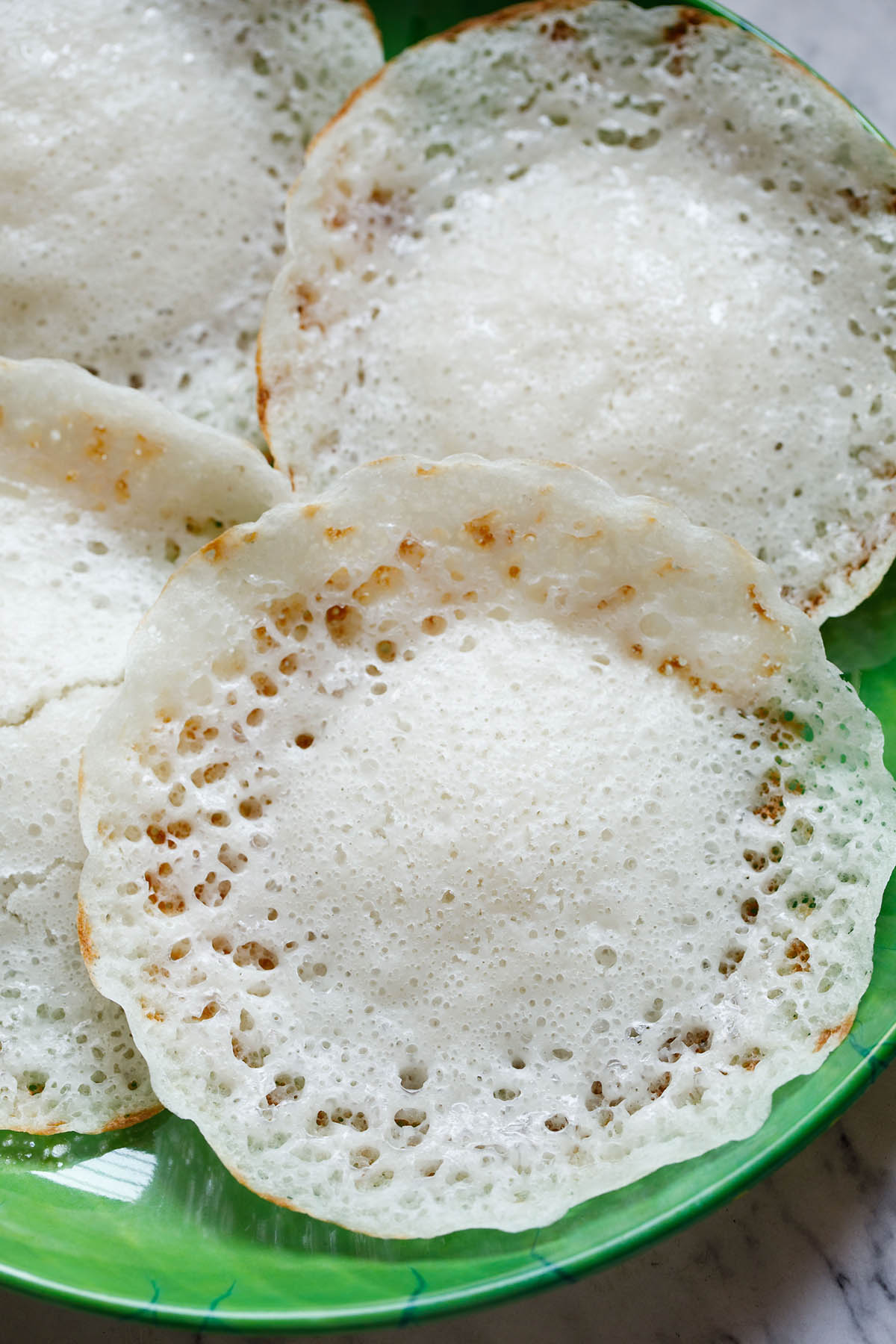
How to Make Appam Recipe
Make Palappam Batter
1. First rinse 1.5 cups regular white rice (like sona masuri, parmal, surti kolam, or ponni rice) in water a few times. Then soak the rice with 2 cups of water in a bowl for 4 to 5 hours. While soaking cover with a lid.
You can use half-half of regular raw rice and parboiled rice. Here I have used sona masuri rice.
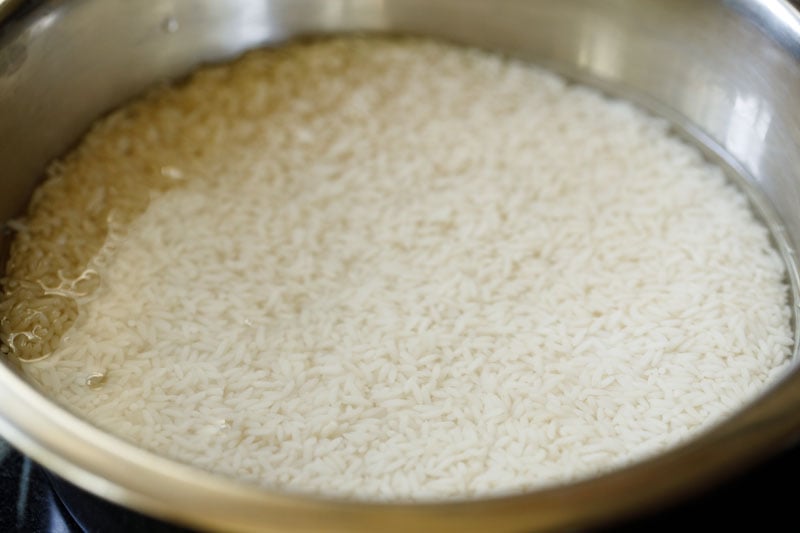
2. Drain all the water and discard it. Add the drained, soaked rice to blender or grinder jar. Also add ½ cup grated fresh coconut, ¼ cup poha (flattened rice), ½ teaspoon salt and 2 tablespoons sugar.
Instead of flattened rice (poha or aval), you can use cooked or steamed rice or puffed rice (murmura).
You could opt to soak the aval or poha with the rice or separately for 30 minutes or add them to the blender after rinsing with water.
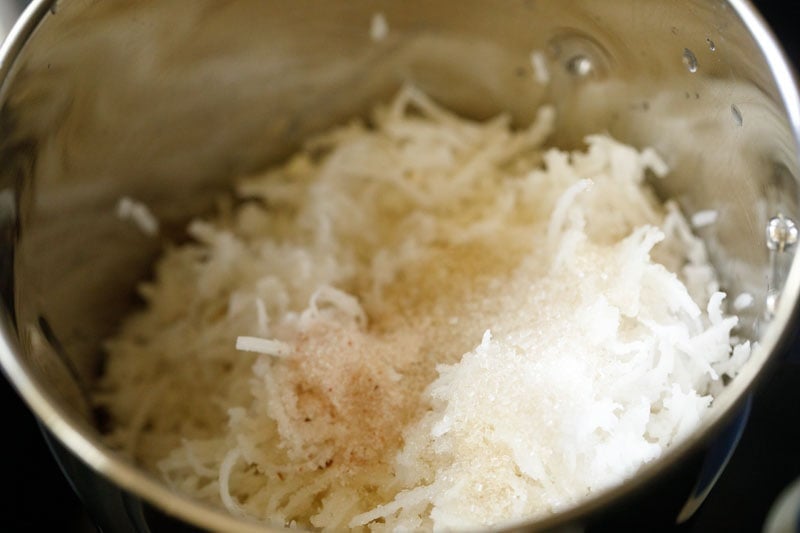
3. Add ¾ cup water (or as needed) and blend or grind the ingredients to a smooth and fine flowing batter.
If in case, the batter looks thin, add a few tablespoons of rice flour to thicken it slightly.
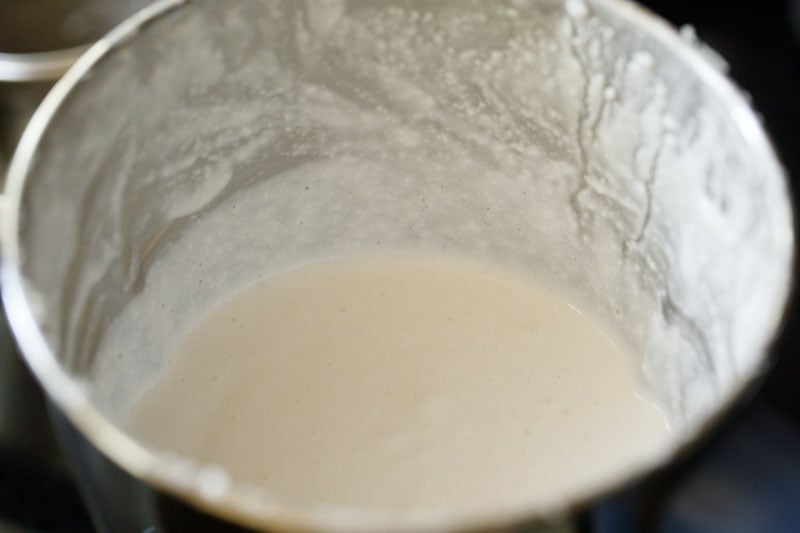
Leaven the Batter
Transfer the batter in a medium to large mixing bowl. Now you have two options when it comes to yeast. I have made this recipe many time with both the types of yeast.
With Instant yeast, the recipe just gets made quicker as the leavening and fermenting time reduces. I have included instructions for both.
4a. If using Dry Active yeast
Mix ½ teaspoon dry active yeast first in 1 to 2 tablespoons of lukewarm water. Add this yeast solution to the batter and mix well. Cover and allow to ferment for 8 to 12 hours, depending on the temperature conditions. The batter will rise and double up the next day.
4b. If using Instant Yeast
Add ½ teaspoon Instant yeast (rapid rising yeast). I have used instant yeast here.
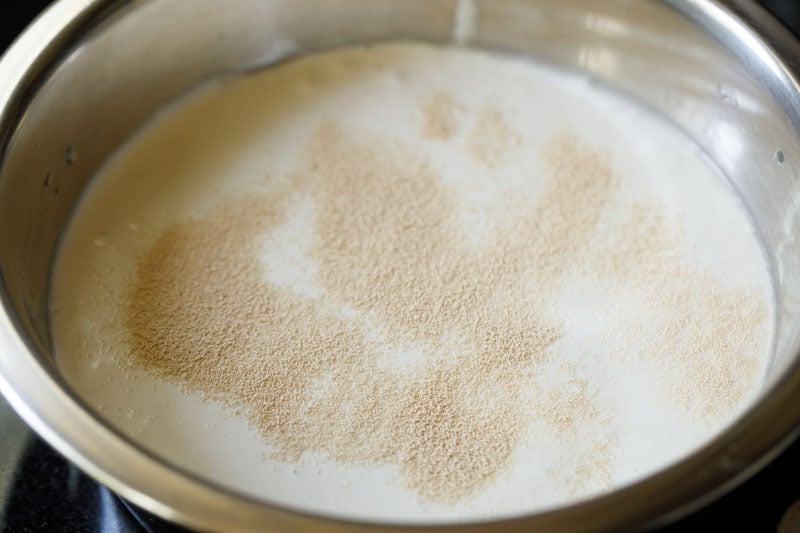
5. Mix thoroughly so that the fine yeast granules dissolves in the batter. Cover and set aside to ferment for 1 to 2 hours. You can also use the instant pot to ferment the batter.
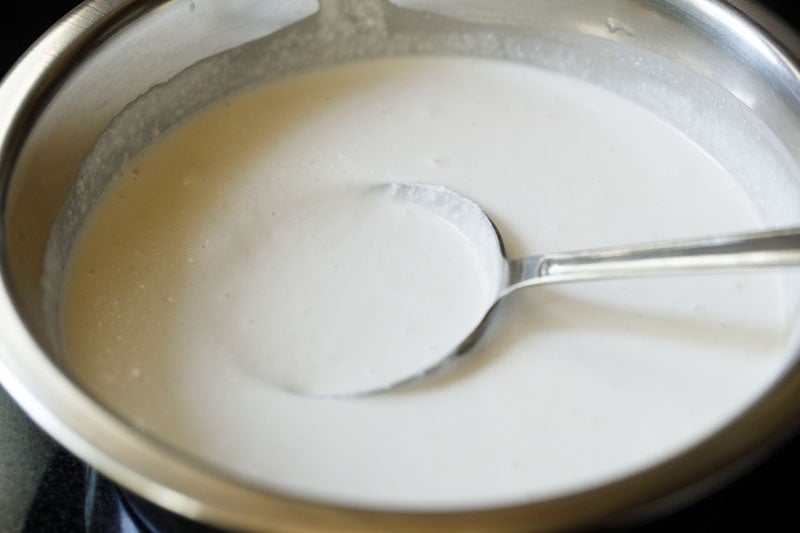
6. After leavening with instant yeast, this is how the batter should look. It will double in volume and you will see air-pockets everywhere.
I had to leaven the batter for a total of 1 hour and 15 minutes as it was a warm climate this day. A cooler weather will take more time.
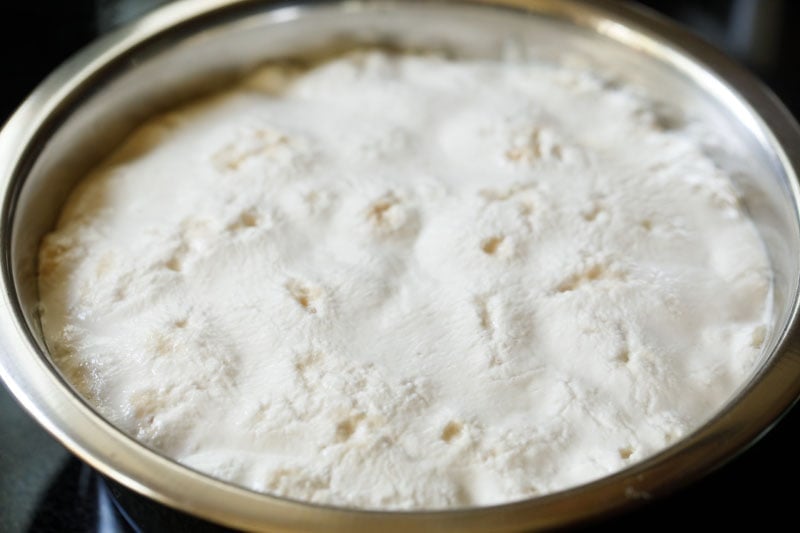
7. A well-fermented batter will have many tiny air-pockets.
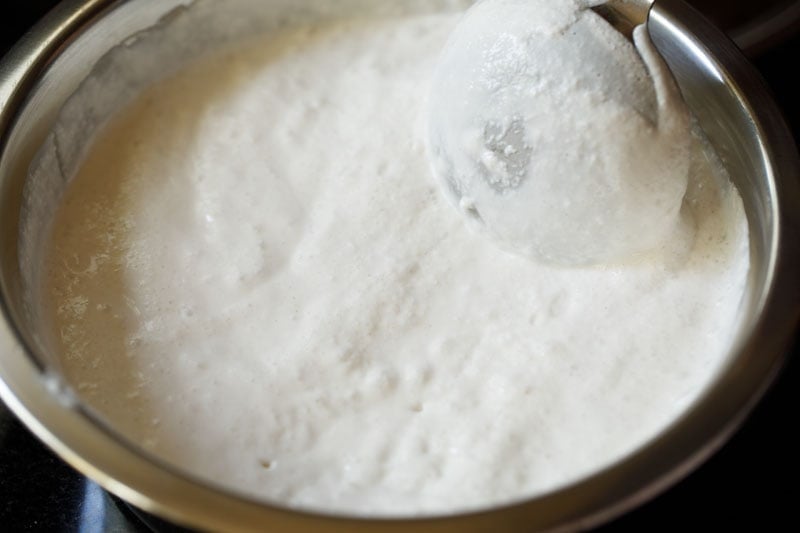
Make Appam
8. Heat an appam pan or a seasoned kadai/wok with handles. Sprinkle about ½ teaspoon oil on the pan and spread it all over on the pan. If using nonstick kadai, then skip smearing the oil.
The appam pan or appachatti works best as you get soft fluffy texture in the center and crisp texture towards the circumference. Spread a ladle full of the batter (about ¼ to ⅓ cup) into the hot pan.
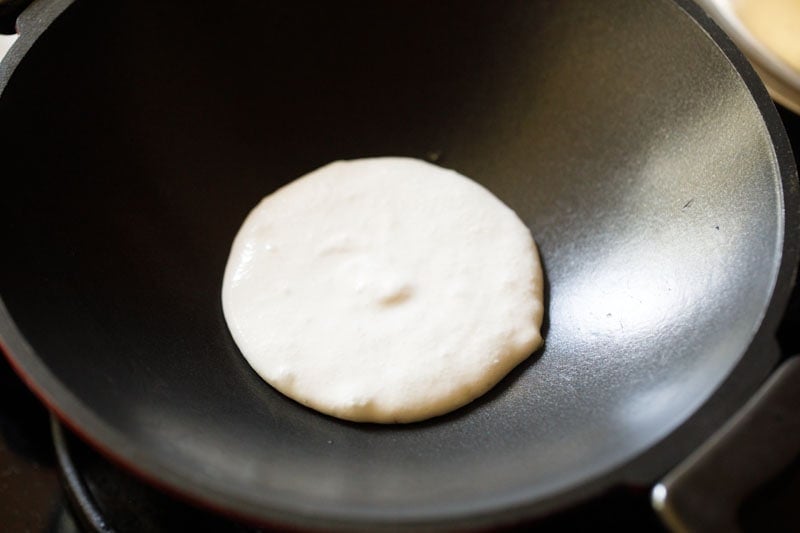
9. Turn and tilt the pan in circles so as to spread the batter into a round circle.
Regulate the heat as needed. If the pan becomes too hot, the batter cooks faster and you won’t be able to make a neat round batter with thin edges and a soft center. So you can reduce the heat or place the pan on the countertop and then pour the batter.
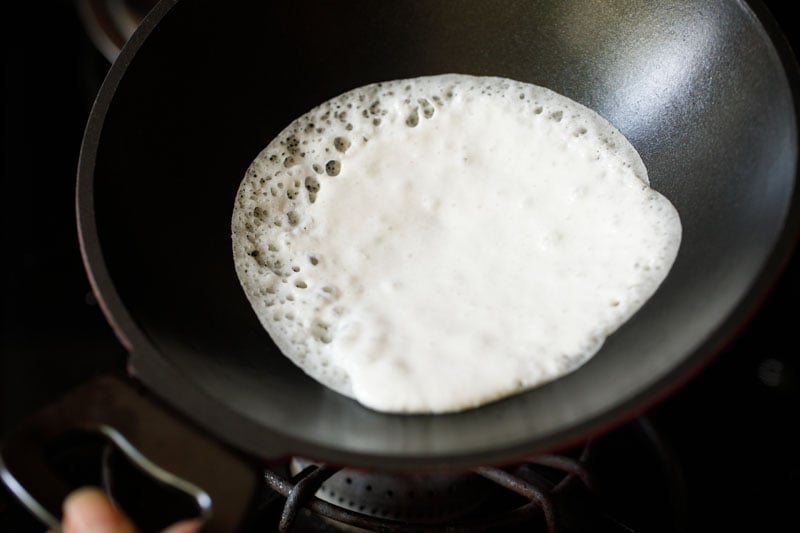
10. Make a neat round circle of the batter. Keep the heat to medium-low or medium.
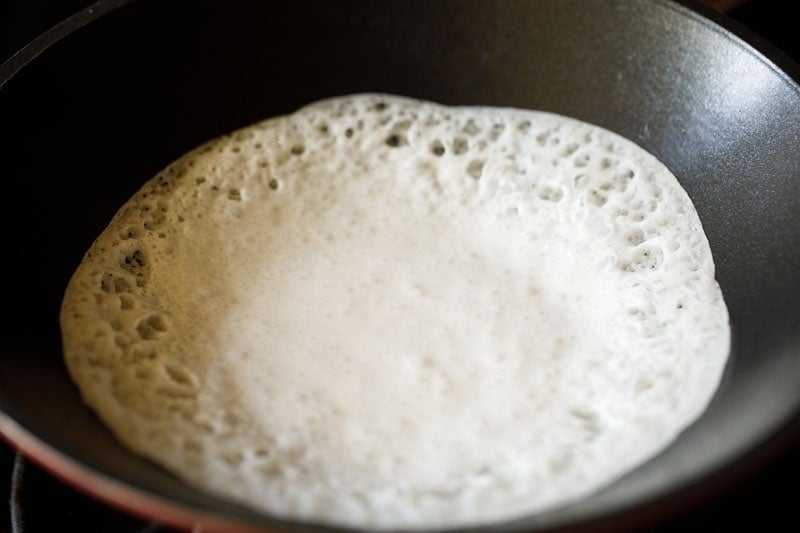
11. You can also drizzle a few drops of oil on the sides if you prefer.
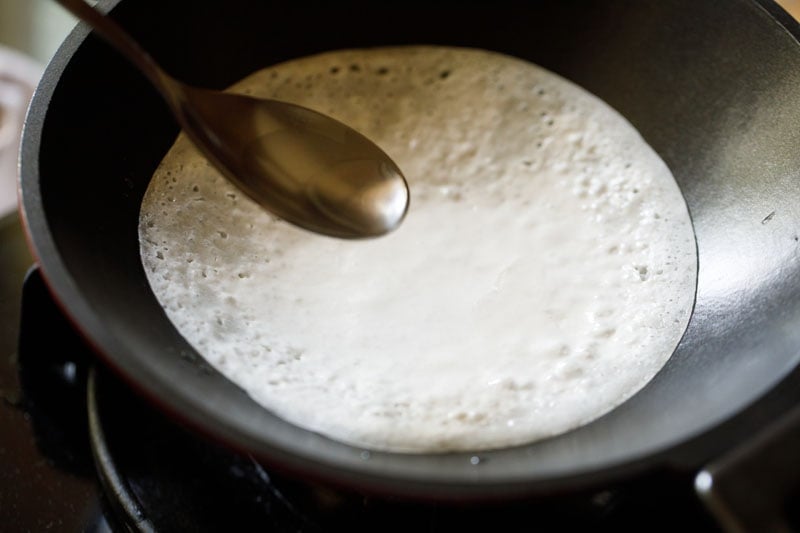
12. Cover the pan with lid and let the appam cook for about 2 minutes or until the base becomes nicely light golden and the center firms up and becomes soft and fluffy.
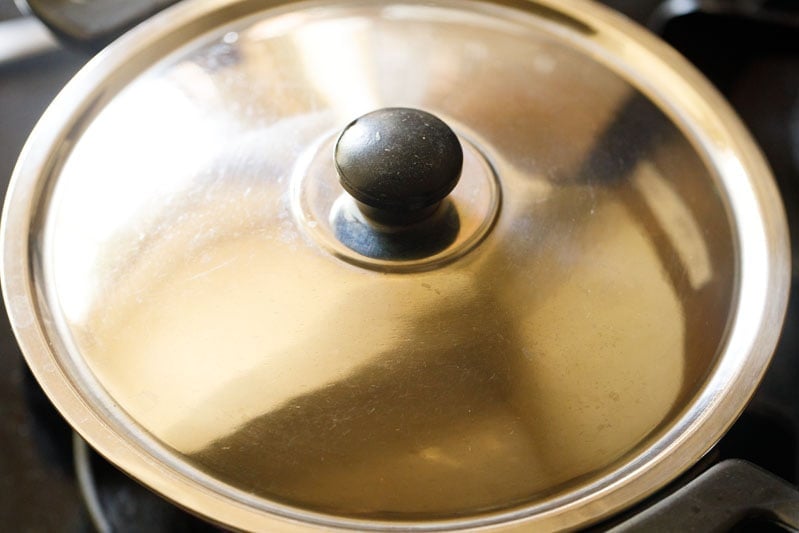
13. Remove and serve appam hot or warm. Repeat with remaining batter to make as may appam as you need. Store any remaining batter in the refrigerator and use within 1 day.
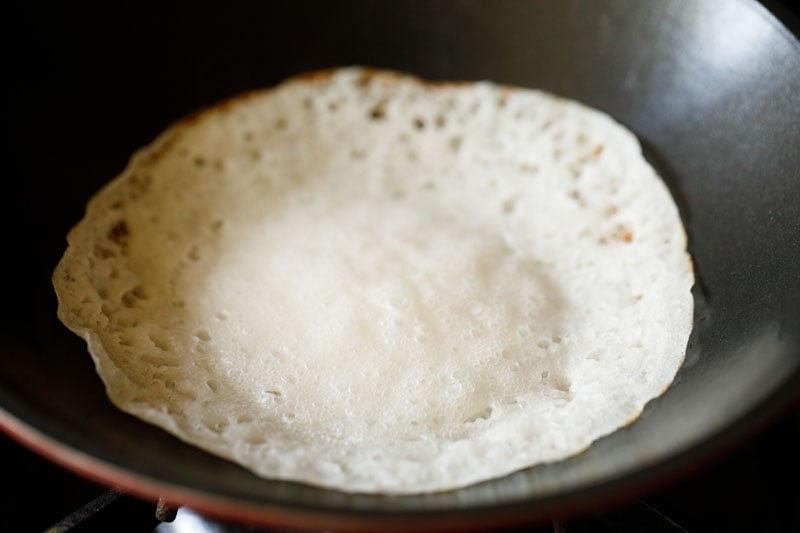
14. Appam goes very well with vegetable stew and sweetened coconut milk. I like to serve them with both! It can also be served with veg korma or potato stew.
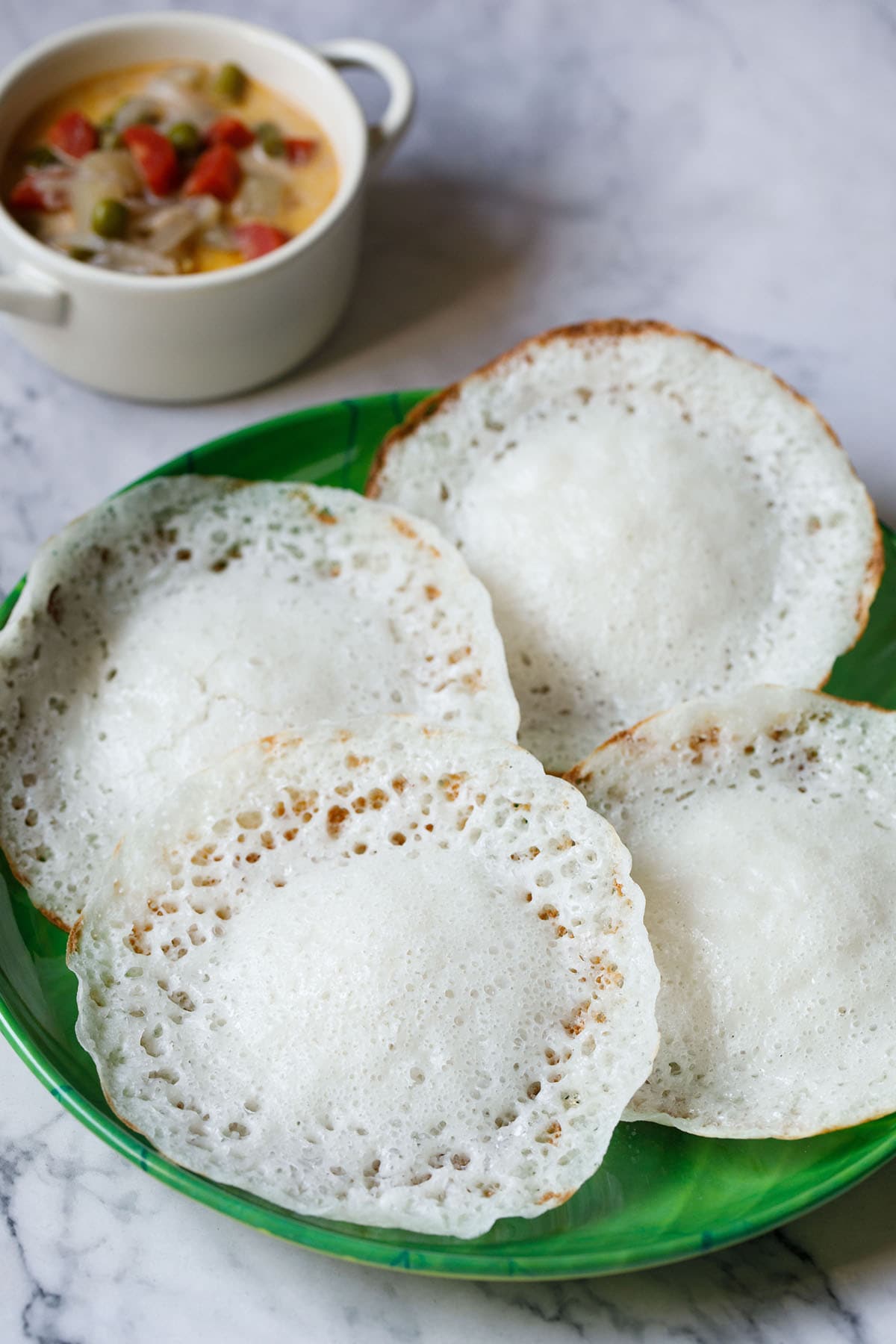
Palappam FAQs
Yeast requires a warm environment to thrive, so the room temperature will affect fermentation. If the room is chilly, you’ll need to allow more time for fermenting.
Alternatively, you can create a “proofing box” with your oven – simply place a cake pan or other deep dish on the bottom shelf of your oven. Place the batter on the top shelf, then close the door. This will provide a nice environment for the yeast to do its work! Make sure the oven is switched off.
Salt can affect fermentation, so my recommendation is:
If you live in a warm or hot climate, then add salt before to avoid over fermentation.
If you live in a cool or cold place, then add salt once the batter is fermented.
Oops! Sounds like you added a bit too much water, making the batter too thin. Next time, reduce the amount of water you add when grinding. To fix this batch, try adding rice flour by the tablespoon until you achieve the batter consistency shown in the photos above.
Uh-oh! Sounds like you over-fermented the batter. Try using the batter at an earlier stage, per the photos in the step-by-step instructions above.
I recommend 2 to 3 appam per person.
Appam batter will last in the fridge for 1 day; any longer and it will begin to turn sour.
As you cook the appam, layer each with a sheet of parchment before stacking another on top.
I suggest any short or medium grain variety of rice, but you can also use a longer grain rice like basmati. Just note that longer grain rice will yield a slightly different consistency than medium or short grained.
You can use desiccated coconut, but the flavor will be different than fresh. You can swap in frozen coconut, though!
More South Indian Breakfast Recipes
Breakfast Recipes
Breakfast Recipes
Karnataka Recipes
Gluten Free Recipes
Please be sure to rate the recipe in the recipe card or leave a comment below if you have made it. For more vegetarian inspirations, Sign Up for my emails or follow me on Instagram, Youtube, Facebook, Pinterest or Twitter.
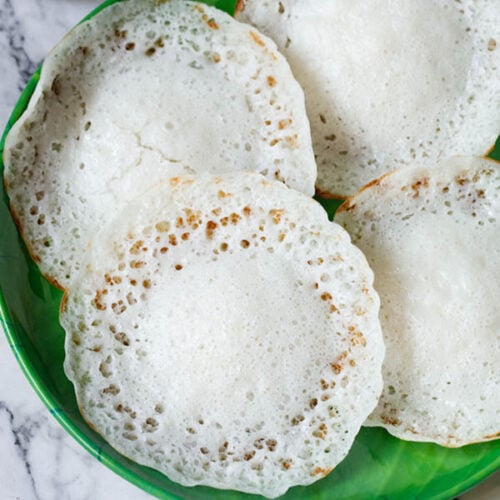
Appam Recipe
Ingredients
- 1.5 cups regular rice or parboiled or half-half of both types
- 2 cups water – for soaking
- ¼ cup thick poha (aval or flattened rice) or cooked rice or puffed rice
- ½ cup grated fresh coconut
- ¾ cup water or as needed for blending or grinding batter
- ½ teaspoon instant yeast or ¾ teaspoon dry active yeast
- ½ teaspoon salt or add as required
- 2 tablespoons sugar or add as required
Instructions
- Rinse rice in water for a couple of times.
- Soak rice in water for 4 to 5 hours.
- Drain all the water and then add the soaked rice to mixer-grinder or blender jar. Also add the grated coconut, cooked rice or poha (aval or flattened rice), salt and sugar.
- You could opt to soak the aval or poha with the rice or separately for 30 minutes or add them to the blender after rinsing with water.
- Add water and grind all the ingredients to a smooth flowing batter
- Transfer the batter in a medium to large bowl.
- With Instant Yeast: Sprinkle the Instant yeast (or rapid rising yeast) all over the batter. Mix thoroughly and evenly. Cover the bowl and set aside to ferment for 1 to 2 hours until the batter doubles in volume and has plenty of air-pockets.
- With Dry Active Yeast: Take about 1 to 2 tablespoons of lukewarm water in a bowl. Then add the dry active yeast and stir to mix well. Add this yeast solution to the batter and mix thoroughly. Cover and keep aside for fermenting overnight or for 8 to 12 hours or more depending on the temperature conditions. The batter will rise and increase in volume the next day. * Check notes
- Heat a kadai or an appam pan with handles at the sides. Spread some oil on the appam pan with a spoon. If using nonstick pan, then skip smearing the oil.
- Spread a ladle full of the batter (about ⅓ to ¼ cup). Turn and tilt the pan so as to spread the batter to a neat round circle. Keep heat to medium-low or medium. Regulate the heat as needed when cooking.
- Drizzle some oil on the sides if you prefer.
- Cover the pan with a lid and let the appam cook. The base would become nicely light golden with crispy edges.
- Gently remove the cooked appam with a spatula. Make the remaining batches of appam this way. If the pan becomes too hot then reduce the heat so that the batter is easy to spread when you tilt the pan.
- Keep the prepared appams covered with a kitchen towel.
- Serve the appam hot or warm with vegetable stew or coconut milk that has been sweetened with jaggery and flavored with a bit of cardamom powder.
Notes
Nutrition Info (Approximate Values)
This Appam Recipe from the archives was first published in April 2014. It has been republished and updated on September 2021.
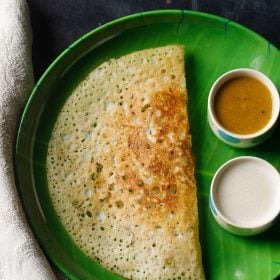

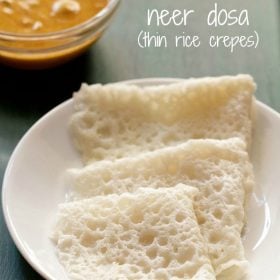
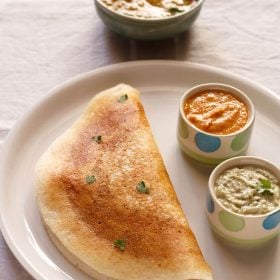
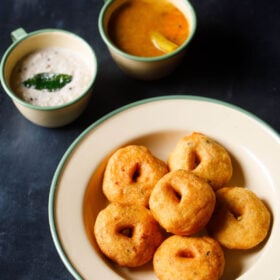
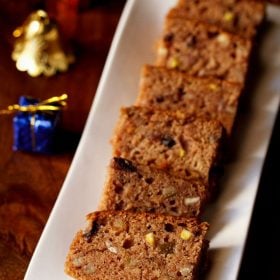
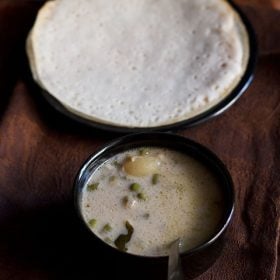
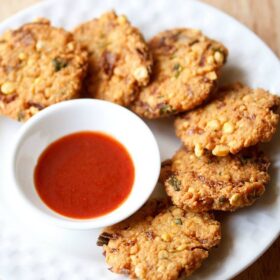








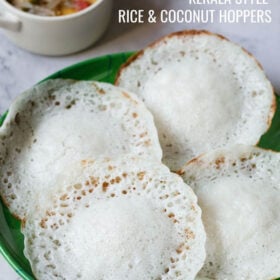
Can I use raw rice for the aapam recipe please?
Thank you!
Yes you can.
Thank you
Is it possible to reduce the sugar or add sugar substitutes to this recipe!
You can add palm sugar or palm jaggery or coconut sugar or jaggery.
Do you have to soak the aval with rice?
You can soak separately for 30 minutes or with the rice or can use it directly while grinding the appam ingredients. But first rinse the aval (poha).
Aapams came out extremely well but they were a bit too crispy. How can I decrease the crispiness?
Try adding more batter into the pan when making the appam. This will help them to be thicker and soft. Thinly spread batter will result in a more crispy texture. Also you can reduce the oil as more oil will also cause them to be crisp.
loved this one..
in fact each recipe on the site is GOLD 🙂
Thanks so much.
It’s been years since I tried appam after moving abroad. And this recipe was perfect!
Great and thanks for letting me know.
We tried this today for breakfast. Very nice and went well with mint coconut chutney. Thanks for recipe
Welcome and thanks for the feedback on the recipe and the rating too.
Your site is my default option for anything I am planning to cook. 🙂
Tried the appam recipe today and I think it could have turned out better. Basically tried half a recipe so used only 1/4 tsp of active dry yeast. Even after keeping it for 15 hours I got only a little bit of fermentation. Should I have added more yeast? Or less water? Not sure what to tinker with next time. Any suggestion will be great. Thanks!
Thanks Anu. The fermentation largely depends on the temperature. A cooler temperature will take more hours for fermentation. The amount of yeast is not the problem. Also try adding slightly more water. Less water can also affect the fermentation. I hope this helps.
Excellent Recipe 👏👏👏👏
Thanks.
Will try that next time.. Thanks for the suggestion
My appams comes out the best!!!
Just awesome
Excellent I must say, I tried this recipe and appams came up really nice and soft. Thanks a lot
thank you for this lovely feedback and the rating on appam recipe. glad to know. most welcome.
Can we use rice flour instead of rice? We can soak it for longer time maybe and add yeast at some stage.
with rice flour, the texture will be different. but you can experiment and try. yeast can be added later too.
Hi Dassana
When u use coconut while grinding and then keeping it outside in room temparature for fermentation, is there any chance that the batter may get bad?
hi sree, the batter does not get bad. the ground coconut along with the rice gets fermented. since the coconut is finely ground and mixed with rice, it does not get spoiled. hope this helps.
Hi Dassana,
You say boiled rice or parboiled rice or Idli rice; is the Idli rice boiled? Also, what’s the difference between cooked and boiled/parboiled?
I haven’t tried making Appams but I gave you 4 stars because I’m an optimist!! Thanks
yes the idli rice is parboiled. cooked rice is raw rice which has been cooked completely and the one we serve with any dal or curry. parboiled rice or boiled rice are rice grains which are partially boiled in the husks. then they are dried and husked. thanks for the rating and i am sure you will love the appam recipe.
Tried the recipe, my first ever try with an appam batter. Turned out perfectly well & everyone enjoyed it thoroughly. Thanks for this wonderful and easy to make recipe.
thank you jubi for sharing this review on appam recipe. glad to know. welcome and happy cooking.
Hi mam,
I tried appam and stew it turn out awesome.
Hello Dassana –
I have tried a few recipes from your site and I must say – your recipes are failproof!!! Excellent instructions and wonderful pictures too. Thank you for creating this site with so many wonderful (both homely and exotic) recipes that we can follow to much praise from our families:) My 5 year old son especially has been a fan of your Mysore Pak and Kaju Katli since he was maybe 3 years old, and they continue to be favorites of his – so this feedback has been long in coming!!
I wanted to ask about appam recipe – does this recipe make for only 5 or 6 appams? So if i need about 15-20 appams i would need to triple this recipe?
Thanks again Dassana
SP
thank you SP. glad to read your positive reviews. the appam recipe does not make 5 or 6 appams. by 5 to 6 servings i meant that the recipe serves 5 to 6 people. this appam recipe will easily yield 15 to 20 appams.
Hello,
I wanted to know after fermentation can we add salt right away and keep it in the fridge or should we should add salt right beforehand we make it ?
if you live in a warm or hot climate, then add salt before to avoid over fermentation. if you live in a cool or cold place, then add salt once the batter is fermented.
Wen I make lace appam it breaks ..y does this happen..pls reply.thanku
could be that the batter is thin. thats why the appams must be breaking. when grinding you can reduce the amount of water than what you add.
one more thing..this time, i made appam as per yr recipe…but got sticky sort of…not soft …
sory to trouble u again…wat cud be the reason….fermentaion was good….
stickiness could be due over fermentation. appam batter if fermented properly won’t be sticky. no problem elizabeth, if any issues happen when making a recipe, you can always let me know.
Followed the recipe exactly and had wonderful appams! Always find your recipes very helpful.
Thanks Daksha. Glad to know this.
I liked the way the measurements change with number of servings. How many Appams in a Serving ?
Thanks Mary. It will be 2 to 3 appams per serving. It depends upon the size of appam you make.
Hi dassana
I dont have parboiled rice .
Can i use regular sonamasoori rice in place of paraboiled rice and
Will that be like 3 cups of rice totally???
chandana, you can use regular rice. yes than that would be 3 cups regular rice.
Hi dassana
What will the shelf life of batter if we keep it in fridge after every usage?
Will it stay for 3-4 days?
it will stay best for 1 to 2 days. more days will make the batter sour.
Hello Dasana!
Can I used normal basmati rice instead of parboiled rice? Would it make any difference Int be appams?
you can use use any short grained variety of regular rice. is using basmati rice, the use tukda basmati rice. that said, you can also use regular basmati rice. some change in the texture will be there if you use regular basmati rice.
other than coconut milk what we can add with dosa batter
you can add some curd.
Hi
Can i stack the appam one on top of the other? Planning to take them on a trip. Will it stick to each other? If so, how can I avoid it?
TIA
they will stick to each other. one way is by keeping banana leaves in between the appams. the other way is by keeping butter paper or parchment paper between them.
May I ask what is the difference between boiled rice and cooked rice. Your recipe says use 1 cup of parboiled or boiled rice and then handful of cooked rice.
merlyn, parboiled or boiled rice as we call these grains are rice which is parboiled or boiled more. then they are dried and pounded to remove the husks. the grains are then sold commercially. this type of rice is used to make idlis as well as appams. cooked rice is rice which is steamed or cooked that we have with any dal or curry.
Hi, I made the appams twice using your recipe and they came out very well.
I have one question though, my appams seem to have a slight sour taste/smell, they are not as sweet as I want them to be. What could I be doing wrong ? I followed the measurements exactly. Maybe I need slightly lesser yeast ?
Preeti, may be its because of the yeast. add less yeast and try.
Hi dear. I made the batter but I forgot to add yeast. Can i substitute it with baking soda or i can add yeast at this stage itself? Please help
narmadha, you can add instant yeast or dry active yeast now. for dry active yeast, dissolve the yeast in 1 tablespoon warm water + pinch of sugar solution. let it bubble and froth for 10 to 15 minutes. then add in the batter. cover and keep aside for 30 to 45 minutes. if using instant yeast, add 1/8th teaspoon (about 2 pinches) directly to the batter. mix very well and keep covered for 30 minutes. you can also add baking soda. so just add 1/2 teaspoon of baking soda. mix very well and then use the batter to make appams.
Thankyou so much dassana… Appam came out super fluffy…my husband loved it! You’re the best
welcome narmadha and thanks for letting me know. glad 🙂
*1/2tb spoon dry yeast
i got it jihana. thats why i gave the suggestion of adding raw rice batter. i hope the recipe has got corrected and turned out good.
Hi … I am planning to make this for tomorrow s breakfast… Hav made the batter n kept.. I made a small mistake instead of 1/2 tea spn i added 1/2 TV spn dry yeast.. do u think it’s going to get over fermented??
yes it will get over fermented. it will also give too much of yeast aroma and flavor. just add 1 cup of idli rava if you have it or soak regular rice in warm water for an hour. then grind it and add to this batter. this will balance the proportion of yeast. adjust sugar and salt as required.
Can I use Goan red rice in place of regular rice?
yes you can use goan red rice.
pleased to know this allie 🙂 glad you liked the appams. thankyou so much and you are always welcome.
Your recipes are toooooo good and superb
thnakyou so much salman 🙂
Made this with the yeast option and fermented it overnight in the oven at 35 degrees C. The batter consistency is tricky and took a little practice. I added a few drops of water after fermenting and throughout from one appam to another until finally the last appam came out almost as good as the ones I had at the Leela in Kovalam. I found that once the right consistency is achieved, the last step in the Kadai becomes better and easier and the appams more authentic, though I still needed practice in this stage too. I used ghee in the Kadai. I will try using Toddy next time but could do with some advice on how much of it to use?
In summary another excellent recipe from Dassana and the wife stamped her approval by eating a hell of a lot of them. I will add my comments on the stew under that recipe…
yes the batter consistency is unlike a dosa batter and it does take practice. try making with coconut oil. the appams tastes damn good. if using toddy, then skip the yeast altogether. you may need to add less water if using toddy. i guess 3/4 cup toddy would be fine for the overall amount of rice used in this recipe. and thank a lot 🙂
Never thought of using coconut oil, good shout. Will do. Thanks.?
welcome rohit
Hi Dassana,
I have found something called Goan Coconut Vinegar (Toddy). Before I buy it, do you reckon this is the same toddy you refer to in the preamble to the recipe? How and what quantity do you think one should use instead of the yeast?
Thanks,
Rohit.
goan coconut vinegar has a very strong flavor, compared to other vinegars. toddy will be different than vinegar. if its toddy then you can add. but if its vinegar then don’t add.
Can we add store bought coconut milk in the grinding?
sony, yes you can.
Hi Dassana,
Tried this appam recipe today. Turned out well. My daughter’s favorite and she loved it. Thank you. I am sharing your link with friends who requested the recipe…..thanks again.
Devi
welcome sakunthala ji. glad to know this. thanks for sharing positive feedback and also for sharing recipe link.
Hi Dassana..
I m trying your appam recipe tonight and i have a query. Can i by any chance use the packaged grated coconut. Its because i don’t have any fresh coconut in hand. Would the final result look/taste any different? Thanks in advance..
by packaged coconut, you mean frozen or desiccated coconut. frozen coconut you can use. but just make sure its within its shelf period and not close to getting rancid. avoid using desiccated coconut. as the final taste will be different than the appams made with fresh coconut.
if i going to take 1kg rice for making appam , so how much quantity off coconut and boild rice and yeast are required?
priya, you will have to check the measurements in google and convert them to kg.
Very nicce recipe.
thanks priti
Hi! Thank you very much for the awesome recipe! I hadn’t made appams since ages and forgot the proportions that I used to use; I tried your recipe and since then have made it three times; each time it has come out superb! My husband and my children thoroughly enjoyed them! God bless you for your clear and thoughtful instructions! Keep up the good work!
thanks rebecca for sharing positive feedback on appam and for your blessings. glad to know that you all liked appams.
What is dry active yeast?
And
what is the meaning of ‘proof the yeast’ separately?
What is yeast proofed solution?
Is yeast = curd ?
I know 2 types of curd, one is fresh curd ( Taza Dahi), a bit sweet in taste, and second one is sour curd ( Khatta Dahi) , this one is a bit old or Basi Dahi.
Kindly help me on my above query.
Warm regards,
Shivam
hi shivam, yeast are unicellular micro organisms. some strains of yeast are beneficial and used in the fermentation & leavening of food like bread, wine and beer. dry active yeast are yeast cells which have been dried and sold commercially. dry active yeast is used for leavening of bread. a yeast proofed solution is a mixture of yeast, warm water & sugar, which activates the dry yeast. they grow and multiply as a result the solution froths and bubbles up. this method is called as proofing.
yeast is not curd or dahi. however in some indian recipes dahi or curd is also used for leavening. here the leavening happens due to the presence of beneficial bacteria in the curd.
Hi,
Thanks for your response.
1) Can we use Khatta Dahi (Khatta Curd) instead of yeast for the fermentation (or leavening) process overnight?
2) From where we get yeast? As I enquired in my city, generally yeast are used by daily needs factory, who have making bread and pav etc. And yeast is sold in quantity, so from where we get one teaspoon yeast?
Also people told me that if we put the yeast in freeze ( refrigerator) it will have bad and strong smell which will spread in other items which we put in freeze using in home.
3) Any suggestive brand/packet of yeast, and quantity which will available in retail market, which we can purchase easily?
4) Which is the ideal shop where we probably get yeast, is it daily needs shop?
5) Can we make yeast in home? Which we can use in this Appam Recipe.
I love appam very much. I used to eat this in one of the pune’s hotel, cituated near nal stop. But this dish is not available easily in all other hotels. And I was left the pune city too. So know finally I decided to learn this dish and will cook in home everyday :-).
Your help will be much appreciated for my above queries. You are doing a Nobel work to help us.
Love and Respect,
Shivam
welcome shivam. before i reply to your queries, you can have a look at this recipe of appam made without yeast – https://www.vegrecipesofindia.com/appam-recipe-no-yeast-appam/
1. in appam curd is not added. appam has a nice faint sweet taste coming from the coconut. curd will change the taste.
2. dry active yeast is sold in most metro cities. you will easily get in the local shops too. the yeast sold by bakeries is fresh yeast. if you are a regular customer then you they may give you some. and fresh yeast has to be stored in the freezer and used quickly as possible in a few weeks. dry active yeast or instant yeast can be stored for many months. usually commercially sold fresh yeast is well packed, so there is no smell that will spread on the other stuff. you can also store it in a box. if the yeast spoils then there will be rotten smell in the fridge.
3. from the indian brands i have used, muksha and blue bird are fine. mauripan/gloripan and red star is good.
4. you will get yeast in any super market. in metro cities the daily needs shop will have yeast.
5. you cannot manufacture yeast at home, but there is an indian technique that draws wild yeast from the air. this method is called as making khameer and is used for the preparation of bhatura or naan where yeast is not added. a reader has suggested that coconut water + a bit of sugar can be fermented (kept for some hours) and then added to the ground rice. this way there is no need to add yeast.
The Appams came out great. I used the “proof the yeast” approach. I had to grind in 2 batches, when the 2nd one became too watery I added rice powder to correct it. Very soft in the center and crisp on the outsides.
Thanks !
welcome george. if the batter becomes thin then adding rice flour is a often used method. thanks for sharing your experience.
I really love appam..it was introduced by an Indian friend…I was wondering at first on what are the Indian food would tastes. .I was amazed when I tried appam with dal curry and something fish curry..thank u…for posting this recipe. I will try it at home too…
welcoem girlie. glad to know this.
Oh, my, goodness. I visited Chennai a couple years ago and was completely ADDICTED to this place that made these and served them with coconut milk. I came home to Seattle to find not a single Indian restaurant that makes these or knows what they are. Thank you so much for posting this!!! I CANNOT wait to try making these!!!
thanks nicole. appams are not difficult to make. you can surely try them making at home.
Mindblowingly soft and lacy appams!
I must admit that although from Kerala, I had yet to perfect the best appam recipe. These were a huge hit at home. Thanks a lot Dassana!
welcome aparna. glad to read this positive feedback from you.
Hi Dassana,
I tried your appam recipe today, I could never imagine it would come out so well. I always wanted to learn this dish and its great pleasure to realize that I can cook it too! Thank you so much. Could you be able to tell me, which one is more healthy, the one with yeast or the one without. I have not tried the one without yeast, however this one above was fantastic, my son loved it! 🙂
thanks archana. both the appam recipes are good. the yeast one has the aroma of yeast. for folks who do not like the yeasty aroma or are satvik vegetarians, the other recipe work well. you can try the appam recipe without yeast too.
Tk for u
To for u
Thanks a lot.your way of presentation is really easy for everyone to follow.
welcome raji
Hi
I tried these appams today. Made the batter last night. Today morning the batter had rose just like in your picture. But when I made the dosa, it didn’t fluffen up 🙁 it was heavy. I still have lots of batter left. Can you please help in me how can I repair the batter? Please 🙁
okay. i am late in replying actually. was not in town. i am wondering what you did with the batter. if you keep it for a few more hours to ferment, the appams will become soft.
Very nice and healthy recipe!!!!
thanks animesh
A list of ingredients, with quantities, would have been useful.
nandita, the ingredient list and quantities are given at the bottom of the post.
Hi, Do you have a simple no grinding recipe for idli. Something similar to https://www.vegrecipesofindia.com/easy-dosa-recipe-rice-flour-dosa/.
I was not able to put my comments in that page.
i don’t have a no grind idli recipe. i still prepare idlis the traditional way. i recently read somewhere about no grind idlis but have not experimented. will sure update if the recipe is a success.
appam can be made with out yeast, i try the it great taset to have it , million ton
could you post recipe of appam without yeast?
gowri, i will post the appam recipe without yeast soon.
Can you make these without yeast?
yes, appams can be made without yeast. i will be posting the recipe shortly.
Appams are such great accompaniment to mild curries in summers. Your tutorials are always wonderful and so helpful for beginners.
oh yum! I have been looking on the web and trying so many appam recipes for long but nothing has worked perfectly for me. I ate a lot of appams during my few months in Kerala and I m surely going to make your recipe. These look lacy and soft and crispy!
appam and ishtu or stew are my all time favorite combo.. nicely done and so well explained
thanks aparna
Thanks for this superb recipe! It worked like a dream on my first attempt itself!
thats nice to know ess. thanks for sharing.